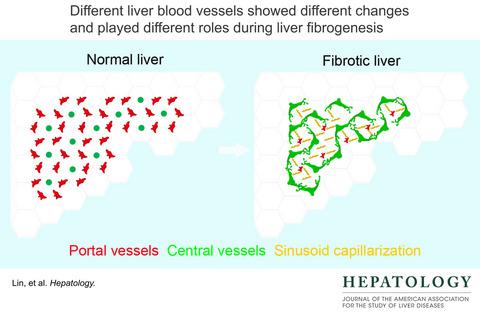当前位置:
X-MOL 学术
›
Hepatology
›
论文详情
Our official English website, www.x-mol.net, welcomes your
feedback! (Note: you will need to create a separate account there.)
A strategy of vascular-targeted therapy for liver fibrosis
Hepatology ( IF 12.9 ) Pub Date : 2021-12-23 , DOI: 10.1002/hep.32299 Yuan Lin 1, 2 , Meng‐Qi Dong 2 , Zhi‐Min Liu 2 , Meng Xu 3 , Zhi‐Hao Huang 2 , Hong‐Juan Liu 4 , Yi Gao 5 , Wei‐Jie Zhou 1, 2, 3, 5, 6
Hepatology ( IF 12.9 ) Pub Date : 2021-12-23 , DOI: 10.1002/hep.32299 Yuan Lin 1, 2 , Meng‐Qi Dong 2 , Zhi‐Min Liu 2 , Meng Xu 3 , Zhi‐Hao Huang 2 , Hong‐Juan Liu 4 , Yi Gao 5 , Wei‐Jie Zhou 1, 2, 3, 5, 6
Affiliation

|
No effective treatments are available for liver fibrosis. Angiogenesis is deeply involved in liver fibrogenesis. However, current controversial results suggest it is difficult to treat liver fibrosis through vascular targeting. There are three different microvessels in liver: portal vessels, liver sinusoids, and central vessels. The changes and roles for each of the three different vessels during liver fibrogenesis are unclear. We propose that they play different roles during liver fibrogenesis, and a single vascular endothelial cell (EC) regulator is not enough to fully regulate these three vessels to treat liver fibrosis. Therefore, a combined regulation of multiple different EC regulatory signaling pathway may provide new strategies for the liver fibrosis therapy. Herein, we present a proof-of-concept strategy by combining the regulation of leukocyte cell-derived chemotaxin 2 (LECT2)/tyrosine kinase with immunoglobulin-like and epidermal growth factor–like domains 1 signaling with that of vascular endothelial growth factor (VEGF)/recombinant VEGF (rVEGF) signaling.
中文翻译:

肝纤维化血管靶向治疗策略
肝纤维化没有有效的治疗方法。血管生成与肝纤维化密切相关。然而,目前有争议的结果表明,很难通过血管靶向治疗肝纤维化。肝脏中有三种不同的微血管:门静脉、肝窦和中央血管。肝纤维化过程中三种不同血管中每一种的变化和作用尚不清楚。我们提出它们在肝纤维化过程中发挥不同的作用,单一的血管内皮细胞 (EC) 调节剂不足以完全调节这三种血管来治疗肝纤维化。因此,多种不同EC调控信号通路的联合调控可能为肝纤维化治疗提供新的策略。在此处,
更新日期:2021-12-23
中文翻译:

肝纤维化血管靶向治疗策略
肝纤维化没有有效的治疗方法。血管生成与肝纤维化密切相关。然而,目前有争议的结果表明,很难通过血管靶向治疗肝纤维化。肝脏中有三种不同的微血管:门静脉、肝窦和中央血管。肝纤维化过程中三种不同血管中每一种的变化和作用尚不清楚。我们提出它们在肝纤维化过程中发挥不同的作用,单一的血管内皮细胞 (EC) 调节剂不足以完全调节这三种血管来治疗肝纤维化。因此,多种不同EC调控信号通路的联合调控可能为肝纤维化治疗提供新的策略。在此处,











































 京公网安备 11010802027423号
京公网安备 11010802027423号